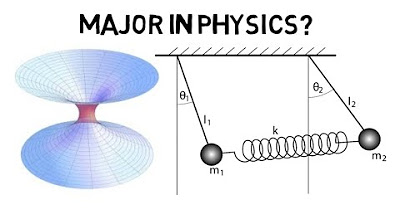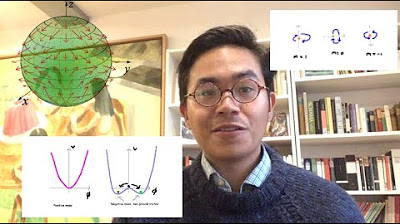The Physics Major
TLDRThe video script delves into the vast and diverse field of physics, highlighting its broad spectrum from the smallest particles to the largest celestial bodies. It emphasizes the variety of subfields such as particle physics, plasma physics, astrophysics, medical physics, and geophysics, each offering unique career paths. The script outlines the foundational courses in a physics major, starting with classical mechanics and progressing to more complex topics like energy conservation, Lagrange's and Hamilton's equations, and the calculus of variations. The discussion extends to quantum mechanics, introducing its probabilistic nature and key concepts like wavefunctions, the Heisenberg uncertainty principle, and quantum entanglement. The video also touches on the practical applications of physics in areas like electronics, medical imaging, and the potential for quantum teleportation, showcasing the subject's relevance in both theoretical understanding and technological innovation.
Takeaways
- 📚 **Physics Major Overview**: Physics is a broad field that includes the study of everything from the smallest particles to the largest celestial bodies, offering diverse career paths and specializations.
- 🚀 **Classical Mechanics**: A foundational course in physics focusing on macroscopic objects like projectiles and satellites, introducing concepts like energy conservation and motion analysis.
- 📈 **Advanced Concepts**: College-level physics introduces more complex ideas such as Lagrange's and Hamilton's equations, which are used to model complex systems and motion.
- 🔢 **Calculus of Variations**: A method from advanced calculus used to find the optimal path or curve for an object under certain constraints, like minimizing time or energy.
- 🌌 **Astrophysics and Astronomy**: Classical mechanics is applied to understand the stability of the solar system and the motion of celestial bodies, including the effects of gravitational forces.
- 🤔 **Quantum Mechanics**: A field that explores the probabilistic nature of particles and energy at the atomic and subatomic levels, introducing the concept of wavefunctions.
- ⚛️ **Heisenberg's Uncertainty Principle**: A principle stating that the more precisely the position of a particle is determined, the less precisely its momentum can be known, and vice versa.
- 🌈 **Quantum Applications**: Quantum mechanics has led to numerous technological advancements, including lasers, MRI, and transistors, which are fundamental to modern electronics.
- 🧬 **Solid-State Physics**: A branch of physics that studies the properties of solid materials from a quantum perspective, with applications in electronics and semiconductors.
- 🌐 **Quantum Entanglement**: A phenomenon where particles become linked and the state of one instantaneously affects the state of another, regardless of distance.
- ⚖️ **Determinism vs. Probability**: A debate in physics regarding whether the universe operates on deterministic laws or probabilistic ones, with quantum mechanics favoring the latter.
Q & A
What is the scope of a physics major?
-A physics major is extremely broad, covering topics from the smallest particles to the largest stars and black holes in the universe. It can lead to a variety of careers in different fields of physics, such as particle physics, plasma physics, astrophysics, medical physics, geophysics, and quantum physics.
Why is it recommended to start with a basic physics major before specializing in a subfield like astrophysics?
-Starting with a basic physics major provides a strong foundation and more breadth and flexibility. It allows students to become more knowledgeable about the fundamentals before specializing in grad school, which can lead to a deeper understanding and more informed career choices.
What are some typical undergraduate courses for a physics major?
-Typical undergraduate courses for a physics major include classical mechanics, electricity and magnetism, thermodynamics, optics, and sometimes quantum mechanics. These courses cover a range of topics from the macroscopic scale, like projectiles and orbiting bodies, to the microscopic scale, like atoms and subatomic particles.
How does the concept of energy conservation apply to a ball thrown into the air?
-When a ball is lifted into the air, it gains potential energy based on its height. Upon release, it loses potential energy as it descends, but gains kinetic energy based on its velocity. The total amount of energy (potential plus kinetic) remains constant due to the conservation laws, assuming no external forces like friction are acting on the ball.
What are Lagrange's and Hamilton's equations in classical mechanics?
-Lagrange's and Hamilton's equations are advanced mathematical concepts used to represent complex systems in classical mechanics. They provide a more powerful way to analyze the motion and forces acting on objects, especially when dealing with multiple degrees of freedom or when the paths of motion are not straightforward.
How does the calculus of variations relate to finding the optimal path for an object under the influence of gravity?
-The calculus of variations is used to find the curve, or path, that optimizes a certain value—in this case, the time it takes for an object to move from one point to another under the influence of gravity alone. This is done by minimizing the time associated with the path, which is analogous to finding a minimum value in calculus but for curves rather than points.
What is the significance of the Euler-Lagrange differential equation in physics?
-The Euler-Lagrange differential equation is crucial in physics for determining the path that minimizes or maximizes a particular quantity along the path of motion. It is used to solve for the optimal paths in various physical scenarios, such as the quickest path for an object to slide from one point to another under gravity.
How does quantum mechanics differ from classical mechanics?
-Quantum mechanics differs from classical mechanics in that it operates on a smaller scale, focusing on atoms, subatomic particles, and light. It is also inherently probabilistic rather than deterministic, meaning it deals with the likelihood of an event occurring rather than predicting exact outcomes. Concepts like wavefunctions and the Heisenberg uncertainty principle are central to quantum mechanics.
What is the Heisenberg uncertainty principle?
-The Heisenberg uncertainty principle states that the more precisely the position of a particle is known, the less precisely its momentum (or velocity) can be known, and vice versa. This principle is a fundamental concept in quantum mechanics that highlights the probabilistic nature of particle locations and movements.
What are some applications of quantum mechanics?
-Quantum mechanics has led to numerous technological advancements, including the development of lasers, MRI machines, transistors, and much of modern electronics. It is also crucial for understanding the behavior of particles in semiconductors, which is essential for electronics and computer engineering.
What is quantum entanglement and why is it significant?
-Quantum entanglement is a phenomenon where two particles become linked and instantaneously affect each other, regardless of the distance separating them. This has implications for quantum computing and quantum information theory, and some physicists believe it could be the basis for teleportation technologies, although not as traditionally understood in science fiction.
Why did Einstein express discomfort with quantum mechanics?
-Einstein was uncomfortable with the probabilistic nature of quantum mechanics and its implications for determinism in the universe. He famously stated, 'God does not play dice with the universe,' expressing his belief that the universe should operate on more deterministic principles.
Outlines
📚 Introduction to Physics Major
The first paragraph introduces the broad scope of the physics major, which covers a wide range of topics from the smallest particles to the largest celestial bodies. It discusses the variety of career paths available to physics majors, including subfields like particle physics, astrophysics, and medical physics. The paragraph emphasizes that most students start with a general physics major and specialize later in graduate school. It outlines the foundational courses that undergraduate physics majors typically take, such as classical mechanics, and touches on the concepts of energy, including kinetic and potential energy, and their conservation.
🔍 Advanced Classical Mechanics and Calculus of Variations
The second paragraph delves into advanced classical mechanics, which includes topics like Lagrange's and Hamilton's equations that offer a more powerful way to represent complex systems. It also discusses the concept of finding the curve that minimizes the time an object takes to slide from one point to another under the influence of gravity, a problem that is solved using the calculus of variations and the Euler-Lagrange equation. The paragraph further explains how physics can be used to analyze entire trajectories and optimize paths, which is crucial in understanding the motion of objects under various conditions.
🌌 Astrophysics, Astronomy, and Fluid Dynamics
This paragraph explores specific areas of interest within classical mechanics, such as the stability of the solar system and the effects of gravitational forces between planets. It also touches on fluid dynamics and its complexities, including turbulence and magnetohydrodynamics, which have applications in geophysics and astrophysics. The paragraph highlights the importance of classical mechanics in understanding a wide range of physical phenomena, from the motion of celestial bodies to the behavior of fluids.
🤔 Quantum Mechanics and its Probabilistic Nature
The third paragraph introduces quantum mechanics, which operates on a much smaller scale and is characterized by its probabilistic nature. It discusses the Heisenberg uncertainty principle, wavefunctions, and the concept of particles being in a superposition of states. The paragraph also covers practical applications of quantum mechanics, such as the development of modern electronic devices and the understanding of atomic and subatomic particles. It concludes with a mention of quantum entanglement, a phenomenon that Einstein found troubling due to its probabilistic implications.
🌐 Applications of Quantum Physics and the Impact on Technology
The fourth paragraph focuses on the practical applications of quantum physics, particularly in the development of technology. It mentions the importance of quantum mechanics in fields like electronics, with the transistor being a key example. The paragraph also discusses the potential for using quantum physics in medical imaging and the improvement of devices like MRI machines. It briefly touches on quantum entanglement and its theoretical implications for teleportation and the transfer of information, concluding with a nod to Einstein's skepticism of the probabilistic nature of quantum physics.
Mindmap
Keywords
💡Physics Major
💡Classical Mechanics
💡Quantum Mechanics
💡Energy Conservation
💡Lagrange's Equations
💡Hamilton's Equations
💡Euler-Lagrange Equation
💡Wavefunction
💡Heisenberg Uncertainty Principle
💡Quantum Entanglement
💡Solid-State Physics
Highlights
Physics is a broad major that covers everything from the smallest particles to the largest celestial bodies.
Physics graduates can pursue diverse careers in fields such as particle physics, plasma physics, astrophysics, and medical physics.
Most students start with a basic physics major and specialize in graduate school.
Classical mechanics is a foundational subject that deals with macroscopic objects and motion.
Energy, in the forms of kinetic and potential, is a key concept with conservation principles.
Lagrange's and Hamilton's equations are introduced as advanced methods to represent complex systems.
The calculus of variations and Euler-Lagrange equation are used to find optimal paths in physics problems.
Quantum mechanics explores the probabilistic nature of particles at a subatomic level.
The Heisenberg uncertainty principle highlights the limits of precision in measuring quantum particles.
Quantum entanglement is a phenomenon where particle properties remain linked over any distance.
Quantum mechanics has significant applications in technology, including electronics, MRI, and lasers.
Solid-state physics, a branch of quantum mechanics, focuses on the properties of solids and materials science.
Einstein's views on quantum mechanics, including his famous quote about God not playing dice with the universe, reflect the philosophical implications of the theory.
Physics majors learn about the stability of the solar system and the effects of gravitational forces between planets.
Fluid dynamics and magnetohydrodynamics are areas of study with applications in geophysics and astrophysics.
The study of quantum mechanics is crucial for understanding the behavior of electrons in transistors, which is essential for electrical and computer engineers.
The concept of a particle in a box in quantum mechanics reveals discrete energy levels and frequencies, which has implications for the emission spectra of gases.
Transcripts
Browse More Related Video

What does a Physics major do? (Part 1: Curriculum and Subfields)

What Math Classes Do Physics Majors Take?

The Complete Physics Major Guide (college classes, internships, career paths)

Lecture 7 | Quantum Entanglements, Part 1 (Stanford)

How Feynman did quantum mechanics (and you should too)

The Math You Need to Study Theoretical Physics!
5.0 / 5 (0 votes)
Thanks for rating: